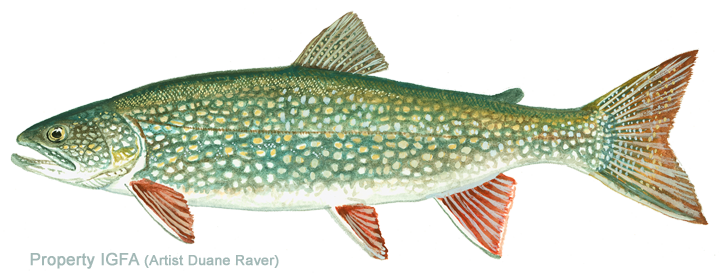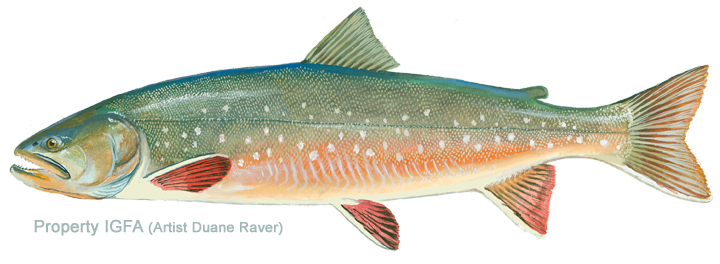Game Fish Identification Reference Guides
Trout, lake
(Salvelinus namaycush)
(Salvelinus namaycush)

(Walbaum, 1792); SALMONIDAE FAMILY; also called mackinaw, Great Lakes trout or char, salmon trout, landlocked salmon, gray trout, great gray trout, mountain trout, laker, tongue, taque, namaycush or masamacush, siscowet, fat, paperbelly, bank trout, humper
It is found throughout most of Canada and well into Alaska as well as the Great Lakes and in sections of the western U.S. where it has been introduced. In the southern portions of its range, or where introduced south of its native range, it seeks out the cooler waters of deep lakes. In northern lakes it may occur in either shallow or deep water. The siscowet (Salvelinus namaycush siscowet), one of three recognized subspecies, is found in Lake Superior at a depth of 300 600 ft (91 183 m). It is called a”fat” by commercial fishermen because the flesh is exceedingly fat and oily compared to the other two subspecies. Of all the chars, it is the least tolerant of salt water and is the only freshwater fish ranging into the far north of Canada and Alaska that has apparently not crossed the Bering Strait.
It is classified taxonomically with the chars (genus Salvelinus), although some scientists prefer to place it in a genus of its own (Cristivomer). Like other chars it has white leading edges on all the lower fins and light colored spots on a dark background, instead of the dark spots on a light background which is characteristic of salmons and trouts. The body is typically grayish to brownish with white or nearly white spots which extend onto the dorsal, adipose and caudal fins. There are no red, black or haloed spots of any kind. It has a more deeply forked tail than other chars, and several rows of strong basibranchial teeth which are weak, less numerous, or absent in other chars. It is a very large char known to grow over 100 lb (45 kg).
It has been crossed with the brook trout (Salvelinus fontinalis) to produce a hybrid known as the “splake” or “wendigo trout”. The hybrid lacks the deep fork in the tail and more closely resembles the brook trout in most respects. There are 65 85 pyloric caeca in the hybrid versus 93 208 in the lake trout and 23 55 in the brook trout.
It has considerable value both as a sport fish and a food fish. The flesh may be white, pink, orange or nearly red, depending on the fish's diet, and is excellent regardless of color. The fatty siscowets are best smoked, but other lake trout are delicious prepared in any manner.
It is extremely vulnerable to pollution, particularly DDT, and this together with the introduction of the sea lamprey into the Great Lakes through the Welland Canal has had a devastating effect on populations. A campaign to control the sea lamprey and the level of pollution has helped restore the stocks in more recent years
It is found throughout most of Canada and well into Alaska as well as the Great Lakes and in sections of the western U.S. where it has been introduced. In the southern portions of its range, or where introduced south of its native range, it seeks out the cooler waters of deep lakes. In northern lakes it may occur in either shallow or deep water. The siscowet (Salvelinus namaycush siscowet), one of three recognized subspecies, is found in Lake Superior at a depth of 300 600 ft (91 183 m). It is called a”fat” by commercial fishermen because the flesh is exceedingly fat and oily compared to the other two subspecies. Of all the chars, it is the least tolerant of salt water and is the only freshwater fish ranging into the far north of Canada and Alaska that has apparently not crossed the Bering Strait.
It is classified taxonomically with the chars (genus Salvelinus), although some scientists prefer to place it in a genus of its own (Cristivomer). Like other chars it has white leading edges on all the lower fins and light colored spots on a dark background, instead of the dark spots on a light background which is characteristic of salmons and trouts. The body is typically grayish to brownish with white or nearly white spots which extend onto the dorsal, adipose and caudal fins. There are no red, black or haloed spots of any kind. It has a more deeply forked tail than other chars, and several rows of strong basibranchial teeth which are weak, less numerous, or absent in other chars. It is a very large char known to grow over 100 lb (45 kg).
It has been crossed with the brook trout (Salvelinus fontinalis) to produce a hybrid known as the “splake” or “wendigo trout”. The hybrid lacks the deep fork in the tail and more closely resembles the brook trout in most respects. There are 65 85 pyloric caeca in the hybrid versus 93 208 in the lake trout and 23 55 in the brook trout.
It has considerable value both as a sport fish and a food fish. The flesh may be white, pink, orange or nearly red, depending on the fish's diet, and is excellent regardless of color. The fatty siscowets are best smoked, but other lake trout are delicious prepared in any manner.
It is extremely vulnerable to pollution, particularly DDT, and this together with the introduction of the sea lamprey into the Great Lakes through the Welland Canal has had a devastating effect on populations. A campaign to control the sea lamprey and the level of pollution has helped restore the stocks in more recent years
















